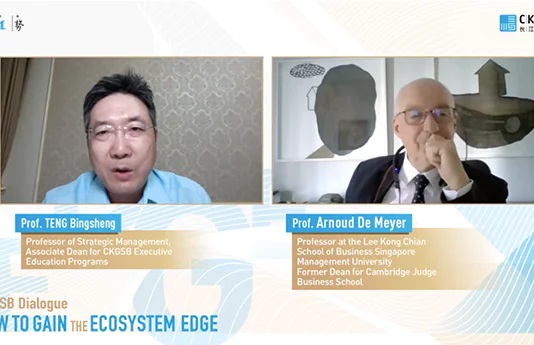Colin Currie, Managing Director of Adidas in China, on the company’s strategy for topping the league table.
When you think of sports brands, there’s pretty much a 50% chance that it’s Adidas that comes to mind. This, after all, is the company that has provided the match ball for the FIFA World Cups, whose final is the most watched sporting event in the world, since 1970. But for all that, success in China hasn’t been a given, and at the turn of the decade Adidas found itself languishing in fourth place behind the likes of Nike and Li-Ning.
Determined to get back to the top of the league table, the company instituted its Route 2015 strategy based around 15 “modules” focused on key growth categories such as football, running, basketball and Adidas’s Originals and Neo brands. Steering them through this period has been Colin Currie, Managing Director of Adidas Group Greater China, and the work has paid off.
“I’m happy to report that we will achieve all our objectives that we set out and we will be back neck on neck with our competitor in terms of being a leading sports brand in China,” says Currie. It shows in the numbers, too—Adidas’s net sales for the first nine months of 2015 in Greater China hit €1.85 billion ($1.97 billion), an increase of 18% on the same period in 2014.
With Route 2015 almost out the way, the company is now looking ahead, and Currie feels confident in their position. “We know we’re one of the hottest brands in China, that our sell-through and revenues are growing and doing well, that our net promoter score is very strong with Chinese consumers, that we have a great foundation to be able to move into the next five years and be able to grow with the market.”
In this interview, Currie tells us about their journey in the last five years and what the company has further down the track.
Q. Going beyond the first-tier cities was a big part of Adidas’s strategy, so in what way was the approach different in these lower-tier cities and what were the kinds of considerations you needed to have?
A. The first thing that we did was we continuously tried to understand the consumer in the different cities and what that city was made out of in terms of demographics and economics. When I first came in, we worked with our consultant partners to be able to put a stake in the ground and at least get the fact base because prior to that, that knowledge was not really well socialized—we had the census at that point of time, which was quite aged. So we had to go out and do our own scientific approach to understand how cities were evolving and what was the percentage of that population within a city that we believed was considered a MAC (middle-class and affluent consumer) population—a MAC to us is middle-class income, consumers who earn over RMB 80,000 on an annual basis. We would consider that segment and we would then populate that, [the] various dynamics, and be able to then tier the cities, because as you know not all cities are tiered equally across the businesses. Having got that understanding, we then essentially laid out the priority in terms of when would we enter those cities, and we would divvy that up between the regions—the east, the west, the north and the south. Once we’d done that fact base, every year we update our 50 key cities within Greater China and we update the data, and then rank the various cities differently depending on what they’re going through in the year, and we also update on an annual basis the lower-tier cities as well.
Q. These stores, how do they fit into the broader strategy and what are the plans for growing the number of stores? How does the bricks-and-mortar retail fit together with e-commerce?
A. The first question we wanted to ask is actually who is buying online? Is it necessary to go into a lower-tier city if the person in the lower-tier city actually is going to go online and buy the product? Is it more convenient for them to do that? Our findings were actually that people who are going online more are in the higher-tier cities and actually in the lower-tier cities what consumers want to do is to go to the provincial capital from their homes and actually go and shop and visit the provincial capital and have that experience rather than go online and buy that product because it wasn’t available [in their hometown].
So having understood the consumer behavior there we’re able to then say, okay, what is our strategy to be able to ensure we can tap into the growing opportunity of consumers who want to purchase online, more in the higher-tier cities, and also their wish to buy from physical bricks-and-mortar, and our strategy is simple—we want Adidas products to be available 24/7 and we want our e-comm[erce] website and online store to be fully integrated and connected to our physical retail, so that if you actually want to buy online and go and visit a store the next day [to collect] you can, and vice-versa. We’re piloting this. The complexity of actually getting this out is we also have our franchisees, so we have to be able to work with them to ensure that we can deliver this seamless brand experience to the consumer through a third party, because only 10-12% of our stores are actually controlled by ourselves. So it’s quite a big project but that is really the opportunity that we see, especially in the next five years physical retail space will essentially for sporting goods be single-digit growth, but our e-comm business will be growing at a very high double-digit, obviously from a smaller base.
Q. How successful has Adidas’s Tmall store been and how have you found the experience of using Tmall as a platform?
A. Tmall to us is like a shopping mall, a marketplace. They are investing in driving traffic and consumers to the shopping mall and we have a shop on this virtual shopping mall. We all know the achievements of Singles Day, and how they’ve actually made a culture out of this…, and we work very closely with them. We’ve found that the e-comm marketplace in the past has been more of a value channel for sporting goods rather than a full-price channel. People who [shopped] online in the last two years have gone there for, okay, maybe I can get it at a discounted price. We’ve found over at least the last 12 months that Tmall is upgrading this and actually people are tending to now buy much more in-season product and full-price product and wanting to have a brand experience on there, which is right in line with our strategy. So we will work closely with Tmall, but we also have our own official site as well where we will position our brand on this site to really be the house of Adidas where you can find all products that you may not find on Tmall or you may not find in the physical store. So that’s our strategy there between really the marketplace, which is probably a much more commercial channel with Tmall, and then our own online store, which is much more a brand experience.
Q. How does the process of urbanization affect the products that you offer and the way that you market them? Do you see an influence in terms of this urbanization affecting what’s popular and how you’re presenting it to consumers?
A. The parallel I draw from urbanization and when we talk about the evolution of a city and consumer segments within the cities is to do with the sophistication of the consumer within the various cities and how quick their behaviors and their needs are changing. So when we talk about our range, a one-size-fits-all approach across a tier-one to tier-six city will not work. Price has a big part to play in affordability when we talk about consumers in different cities and also how they’re going through the evolution of their life in terms of the sports that they play. So down in the lower-tier cities we know that a sport such as running is very popular, or sport related to Chinese culture, so more martial arts, etc. As you get into the higher-tier cities, despite there being a big running boom anyway across multiple cities, playing soccer or playing basketball [are popular]—there’s a wider choice of sports. So we understand that different sports are played in different cities based on, I would say, the evolution and the sophistication of the consumer, which is linked to urbanization as urbanization is one of the key drivers [of that sophistication].
When we look at our assortment therefore, in a lower-tier city generally speaking a consumer may only be able to afford a set of footwear on a periodic basis, or apparel, and they would use that for different occasions, be it playing sport, doing recreational sport or even going to work or going to a wedding. Whereas in Shanghai now that there is so much choice as well with different brands, so we’re finding consumers are buying different sets of apparel and footwear for different occasions and they’re much more buying our product for sport only or for recreational sport. Which would therefore mean when you go to market, in a store what you would offer would be quite a wide range of categories for a higher-tier city, whereas in a lower-tier city we would be much more focused maybe on running and training and not offering a high-price point football product or basketball product. We would still have an offer of those categories, but they wouldn’t be the extensive range you’d find in the higher-tier cities.
So this is essentially how we carve it out, and you would ask, how do you know? Essentially, we look at the sales stream data, and we are connected to [around] 6,000 stores on a daily basis—we get the sell-through data and we can actually look at a store and say, okay, this product is selling faster than this product, the reasons why so we can tailor product better for future seasons to be able to be much more focused.
Q. Adidas has pinpointed six influential global cities and Shanghai is one of them, so how does Shanghai feed into Adidas’s work?
A. The six cities strategy is about picking six key influential cities around the world that will drive the trends and create the halo of the brand into their geographical areas. And here in China we believe that Shanghai is the leader in culture. It’s a financial hub, it has great universities, it has a great pool of youth, and therefore out of all the cities that we have here—and we talked about the top 50 cities, we also tailor that down and focus on top 23 cities as well which are essentially tier one, tier two—Shanghai is the metropolis we believe that consumers aspire to, will visit and therefore whatever we can do in Shanghai will be the window to the rest of China. So we will execute the best store formats or concepts firstly in Shanghai and then we will roll it out. If we have an activation nationwide, we will have the finals of it, or the closing of it in Shanghai. We really want Shanghai to be that window into China for the rest of the country, and also to be our model city so that we can actually plan our distribution here, plan how our brand is seen and own this city and then scale into the next set of cities, which will be for us in Greater China: Beijing, Guangzhou, Hong Kong, and then tier it down into the Chengdus, the Wuhans, etc. And strategy in the end for us in China would be how do we own these top 23 cities through distribution, through brand activation and through really connecting to consumers.
Q. How has Adidas made use of sponsorship?
A. Sponsorship is a key part of our marketing strategy. Partnering with teams or key assets is an important strategy for us, so we have a host of assets and teams that we sponsor, most notably the CVA, the China volleyball women’s team that just won gold in the volleyball championship this year. We partner with Liu Hong, who won gold in walking at the IAAF (International Association of Athletics Federations) [World Championships], we sponsor some up-and-coming tennis stars, amongst others. It’s important that we’re associating our brand with who we believe are the athletes who we can support to perform better on the court.
The other part of our strategy is investing in grassroots. The government is investing heavily in sport—RMB 1 trillion ($157 billion) by 2025—and really driving that kids are given an opportunity to do sport as part of their curriculum, and we believe that this is a really important aspect and channel of our sponsorship strategy or marketing strategy. We just launched a couple months ago a partnership with the Ministry of Education—we will reach 20,000 schools and give kids the opportunity to play football.
Part of that deal was launching an app that has virtual football coaching that kids can go into free and learn about the basics of playing football in order to advance skills. This is for us to connect with kids for the future, but also about us giving back to the community—we’ve had a long history here in China, we’ve been able to grow here, and being a responsible, good corporate citizen is an important aspect to also be able to give back to the Chinese community.
Q. Away from the more performance-related products and into the recreational sportswear, casual sportswear like Adidas Originals, what is their place in the overall plan? How does it need to be approached differently?
A. First and foremost, sport is the core to our business—it is over 75% of our business, it will always remain the core of our business, especially as we now see that more and more consumers are starting to participate in sport. So sport is and will always be the core of our business and the core of our strategy moving forward.
Now on the recreational sport, lifestyle area this has been in the last five years probably something that the Chinese consumer has been more interested in because sport wasn’t top of their mind five years ago, or participating in sports—following sports is different, all Chinese consumers will follow the finals of the 100 meters—but actually [a far lower percentage were] participating in sports. Therefore, the opportunity to offer our products, footwear and apparel to people who were doing recreational sport like jogging or walking, etc. has been there and we have two brands Originals and Neo (a mid-market sports casual brand) and together with our sports performance core brand this is a competitive advantage versus any other brand offering. And we say, actually Adidas has the breadth of footwear and apparel that can meet an athlete’s needs or a kid’s needs on court, but we also provide products, footwear and apparel for their off court needs. So we actually want to own that whole 24-hour life of a person who wants to do sport.
Q. How do the other parts of the Adidas Group, such as Reebok, sit in relation to the core Adidas offering?
A. We have been running [Reebok] in line with the global positioning of a fitness brand. The business is smaller than the Adidas business, but we focus it on more of the niche segment, which is focused on real tough fitness, and also women who want to go to the gym. And if you look at what the Reebok brand is doing globally it’s involved in a lot of team activities like Spartan Race or CrossFit or some aspects of Boot Camp. Now those activities are not yet here on a mass scale, but they will come here one day and there will also be a movement like with running here. We believe in this sort of sport and when it is here we will be able to employ our Reebok business on a much far wider scale to tap into that. We want to keep the Reebok brand focused on tough fitness, but there’s another side of the brand that is doing well here, which is our Classics, because obviously Reebok has a heritage as well and at the moment that side of the business is doing really well.
Q. We talked about the Route 2015 and you say you’ve matched your goals there. So what’s next for Adidas in China?
A. At the end of 2013 we did another big study, which went on for a good part of six months, and then developed our 2020 strategy, which was completed at the end of 2014. We’re now in the middle of that transition to our 2020 strategy, which I think we will talk about in the months to come, but essentially it’s an evolution of our 2015 plan—it’s not a revolution. We’re evolving our strategy to be much more focused on the segments that we believe will grow in China and one of them is kids. So in the last five years kids hasn’t been a big focus for us, but in the next five years kids will be a big growth driver for us. As I explained, the schools start to do sport, the investment, so this will be a big growth driver. So we’ve got our 2020 plan and we have our vision and our vision simply is also to win the hearts and minds of our consumer and be the best sports brand in Greater China, so we want to really concentrate on that emotional connection with our consumers in the next five years, which requires different sorts of competencies again in terms of ensuring that the consumer has a great brand experience every time they engage with us and they’re actually an advocate for us and not a detractor. So that will be our focus and we continue to strive to obviously stay at the top of the market





















